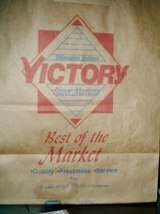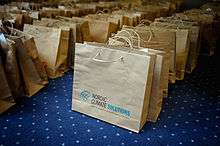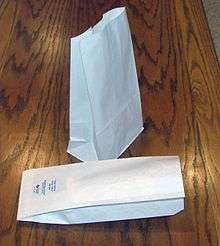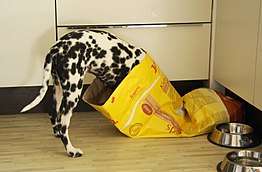Paper bag


A paper bag is a bag made of paper, usually kraft paper. Paper bags are commonly used as shopping bags, packaging, and sacks.
History
In 1852, Francis Wolle, a schoolteacher, invented the first machine to mass-produce paper bags.[1] Wolle and his brother patented the machine and founded the Union Paper Bag Company.
In 1871, inventor Margaret E. Knight designed a machine that could create flat-bottomed paper bags, which could carry more than the previous envelope-style design.
In 1883, Charles Stilwell patented a machine that made square-bottom paper bags with pleated sides, making them easier to fold and store.[2] This style of bag came to be known as the S.O.S., or "Self-Opening Sack".[3]
In 1912, Walter Deubener, a grocer in St. Paul, Minnesota, used cord to reinforce paper bags and add carrying handles. These "Deubener Shopping Bags" could carry up to 75 pounds at a time, and became quite popular, selling over a million bags a year by 1915. Paper bags with handles later became the standard for department stores, and were often printed with the store's logo or brand colors.
Plastic bags were introduced in the 1970s, and thanks to their lower cost, eventually replaced paper bags as the bag of choice for grocery stores.[4] With the trend towards phasing out lightweight plastic bags, though, some grocers and shoppers have switched back to paper bags.[5]
In 2015, the world's largest paper shopping bag was made in the UK and recorded by Guinness World Records.[6]
Production
Standard brown paper bags are made from kraft paper. Tote-style paper bags, such as those often used by department stores or as gift bags, can be made from any kind of paper, and come in any color. Paper bags can be made from recycled paper, with some local laws requiring bags to have a minimum percentage of post-consumer recycled content.[7]
Litho – printed for the best result. Very nice and sharp colors can be printed by lithographic technique in production of laminated paper bags.[8]
Single layer

Paper shopping bags, brown paper bags, grocery bags, paper bread bags and other light duty bags have a single layer of paper. A variety of constructions and designs are available. Many are printed with the names of stores and brands. Paper bags are not waterproof. Types of paper bag are: laminated, twisted, flat tap. The laminated bag, whilst not totally waterproof, has a laminate that protects the outside to some degree.
Multiwall paper sacks


Multiwall (or multi-wall) paper sacks or shipping sacks are often used as shipping containers for bulk materials such as fertilizer, animal feed, sand, dry chemicals, flour and cement. Many have several layers of sack papers, printed external layer and inner plies.[9] Some paper sacks have a plastic film, foil, or polyethylene coated paper layer in between as a water-repellant, insect resistant, or rodent barrier.
There are two basic designs of bags: open mouth bags and valve bags. An open mouth bag is a tube of paper plies with the bottom end sealed. The bag is filled though the open mouth and then closed by stitching, adhesive, or tape. Valve sacks have both ends closed and are filled through a valve. A typical example of a valve bag is the cement sack.
Recycling
Paper bags are readily recyclable. Plastic or water-resistant coatings or layers make recycling more difficult.[10]
See also
References
| Wikimedia Commons has media related to Paper bags. |
- ↑ "Patent US9355". Retrieved March 6, 2013.
- ↑ "Charles Stilwell". Ohio History Central. Retrieved 2015-06-10.
- ↑ MoMA | Margaret E. Knight and Charles B. Stilwell. Flat-Bottomed Paper Bag. 1870s-1880s
- ↑ Ball, Jeffrey (2009-06-12). "Paper or Plastic? A New Look at the Bag Scourge". The Wall Street Journal. Retrieved 2015-06-11.
- ↑ Pereira, Andrew (2015-06-09). "Oahu's bag ban includes exemptions and substitutes". KITV.com. Archived from the original on June 13, 2015. Retrieved 2015-06-11.
- ↑ "largest shopping bag made from paper". Guinness World Records.
- ↑ "California - Bag Legislation". BagLaws.com. 2014-09-30. Retrieved 2015-06-11.
- ↑ "BRU London Limited". printedpaperbagsdirect.co.uk. Retrieved 2016-01-09.
- ↑ Paulapuro, Hannu (2000). "5". Paper and Board grades. Papermaking Science and Technology. 18. Finland: Fapet Oy. pp. 121–122. ISBN 952-5216-18-7.
- ↑ R. McKinney: Technology of Paper Recycling, 1995, p. 351. ISBN 9780751400175
Books
- Yam, K. L., "Encyclopedia of Packaging Technology", John Wiley & Sons, 2009, ISBN 978-0-470-08704-6